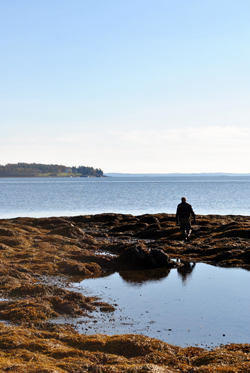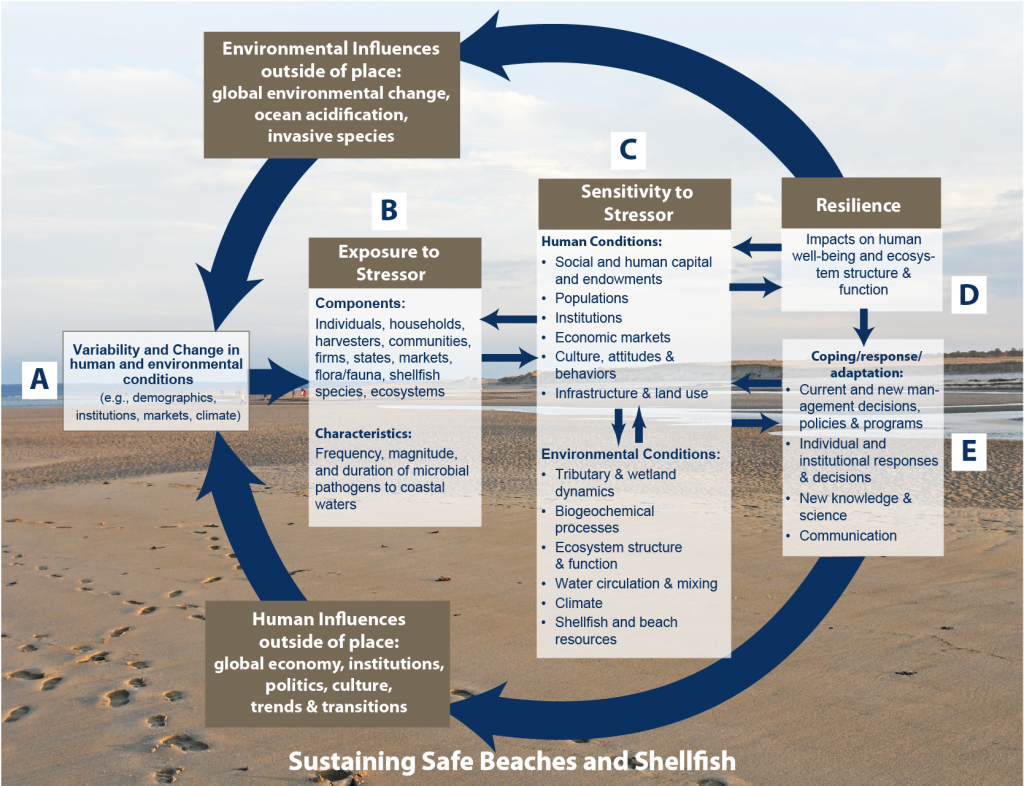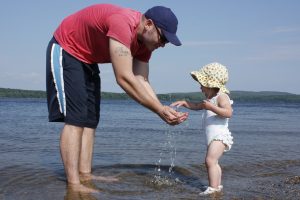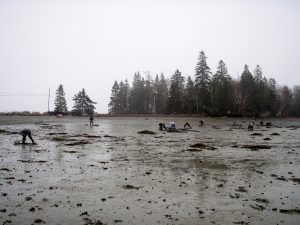Safe Beaches & Shellfish Beds (NEST)
Water Quality and Public Health Issues for Coastal Communities

Linking Science to Decision-Making
Lead Institutions: University of Maine, University of New Hampshire
Sponsor: National Science Foundation
The Safe Beaches and Shellfish Project is the first project of the New England Sustainability Consortium (NEST). NEST began in 2013 as an ambitious effort to build research capacity by integrating strengths of multiple small universities and colleges in Maine and New Hampshire and by combining and growing these strengths through new collaborative research partnerships. With the addition of a second project in 2015, The Future of Dams, NEST has expanded to include Rhode Island institutions.
Research thrusts
This Safe Beaches and Shellfish Project addressed water quality and public health issues of importance to many coastal communities regionally and nationally.
- Early, active, and iterative engagement with diverse stakeholders resulted in a broad suite of impacts from this work and advancements in the theory and practice of sustainability science discipline. For example, a Decision Support System (DSS) is under development based on an integrative conceptual model linking bacterial source, delivery, and residence time processes. The DSS uses a suite of water quality datasets and analytical tools developed in partnership with state agencies, nonprofits, and individuals.
- Coast-wide research focused on patterns and relationships among coupled natural and social systems that influence the resilience of beaches and shellfish. Coast-wide analysis of coupled social and natural processes, decision making, and use and production of science were combined to improve understanding of system interactions that contribute to high levels of microbial pathogens and indicator bacteria in coastal waters and influence system responses.
- Place-based research employed a multi-case study design to provide deep understanding of social and biophysical phenomena in places and at scales relevant to stakeholders and informative to coast-wide understanding.
Intellectual Merit
A conceptual model brought together the social-ecological systems research focused on sources, delivery, and residence time with parallel consideration of factors that influence connections between scientific knowledge and decision-making. This conceptual model served as an important boundary object to coordinate across six different disciplines spanning the natural and social sciences: hydrogeomorphology, environmental communication and sustainability science, marine biology and oceanography, microbiology, spatial information sciences, and macro-ecology.
Decision support systems (DSS) provided information to individuals, municipal officials, state and national coastal programs, aimed at management of both beach and shellfish resources. The portfolio included products (data, maps, tools, models); interactions to better understand information needs and design decision support processes; and knowledge-action systems or networks comprised of individuals, organizations, communication networks, and supporting institutional structures.
To prevent human illness from pathogenic Vibrio species affecting shellfish methods were developed to detect the actual pathogenic strains of Vibrio species and a patent application was filed for a new assay to detect V. parahaemolyticus in oysters. Forecasting models of the incidence and concentrations of pathogenic vibrios in regional shellfish harvest areas were developed to inform harvest management practices to reduce risks of vibrio-borne illness associated with raw shellfish consumption.
A model for prediction of watershed microbial contamination along the Maine coast, including a new high-resolution topographic map of the coastline delineating boundaries of watersheds and drainage networks, was developed. A hydrodynamic and particle tracking model was developed with stakeholders to enable investigation of estuarine parameter space with different combinations of environmental forcings.
At the conclusion of the project in July 2016, 42 peer-reviewed publications had been published and 25 manuscripts are in review or development. Thirty-two competitive, peer-reviewed awards had been received, representing $30,235,968 in follow-on funding to extend research efforts initiated by the project.
Broader Impacts
The Safe Beaches and Shellfish Project supported research that is relevant to diverse coastal decision makers by providing analyses, information, data, and models and building shared research capacity. Researchers and stakeholders collaboratively refined the questions, methods, and the identification of potential solutions, such as the development of the DSS and the identification of management trigger levels for beach and shellfish bed closures. Research data is publicly available on the NH EPSCoR Data Discovery Center (https://ddc.unh.edu/). Relationships were developed or strengthened with stakeholders from 35 state agencies, municipalities, non profit organizations and businesses.
Research Training
Developing a cadre of young scientists with a strong disciplinary foundation as well as interdisciplinary sensibilities is a focus of NEST. Students collaborated with scientists from different disciplines and interacted with key stakeholders to better understand how sustainability science can help inform and address coastal environmental concerns. This project provided training for six post-doctoral associates, 41 graduate students and 53 undergraduates, across eight institutions.
Cross-disciplinary courses on applied sustainability science were offered to students in both states via real-time videoconferencing. Keene State College developed a new academic course focused on genomic analysis, including a novel bioinformatics class for both biology and computer science majors. University of New England students were trained on methods for conducting stakeholder engagement in the context of sustainability science within an undergraduate curriculum.
Publications
Newman, G., Chandler, M., Clyde, M., McGreavy, B., Haklay, M., Ballard, H., Gray, S., Scarpino, R., Hauptfeld, R., Mellor, D., and Gallo, J. 2016. Leveraging the power of place in citizen science for effective conservation decision making. Biological Conservation. doi:10.1016/j.biocon.2016.07.019
Buscombe, D., Grams, P.E., Smith., S.M.C. 2016. Automated Riverbed Sediment Classification Using Low-Cost Sidescan Sonar. Journal of Hydraulic Engineering, 142(2), 06015019. Doi 10.1061/(asce)hy.1943-7900.0001079.
Cole, K. L., Hetland, R. D. 2016. The Effects of Rotation and River Discharge on Net Mixing in Small-Mouth Kelvin Number Plumes. Journal of Physical Oceanography, 46(5), 1421–1436. doi:10.1175/jpo-d-13-0271.1
Druschke, C.G., McGreavy, B. 2016. Why rhetoric matters for ecology. Frontiers in Ecology and the Environment, 14(1), 46–52. doi:10.1002/16-0113.1
Evans, K., Athearn, K., Chen, X., Bell, K.P., Johnson, T. 2015. Measuring the impact of pollution closures on commercial shellfish harvest: the case of soft-shell clams in Machias Bay, Maine. Ocean and Coastal Management, 130: 196-204, published online 25 June 2016. DOI:10.1016/j.ocecoaman.2016.06.005
Levesque, V., Bell, K.P., Calhoun, A.. 2016. Planning for sustainability in small municipalities: The influence of interest groups, growth patterns, and institutional characteristics. Journal of Planning Education and Research, published online 08 July 2016 before print. doi: 10.1177/0739456X16655601
Lindenfeld, L..A., Parasecoli, F. 2015. Feasting Our Eyes: Food Films, Cultural Citizenship, and American Identity. Columbia University Press, November 2016, ISBN 9780231172509.
McGreavy, B., Calhoun, AJK, Jansujwicz, J., Levesque, V. 2016. Citizen science and natural resource governance: program design for vernal pool policy innovation. Ecology and Society, 21(2), 48. Doi 10.5751/es-08437-210248.
Smith, H., Suldovsky, B., Lindenfeld, L. Science and policy: scientific expertise and individual participation in boundary management. Journal of Applied Communication, 44(1), 78-95. Doi 10.1080/00909882.2015.1116707.
Smith, S.M.C., Wilcock, P.R. 2015. Upland Sediment Supply and its Relation to Watershed Sediment Delivery in the Contemporary Mid-Atlantic Piedmont (U.S.A.). Geomorphology, 232: 33-46. doi: 10.1016/j.geomorph.2014.12.036
Suldovsky, B. 2016. In science communication, why does the idea of the public deficit always return? Exploring key influences. Public Understanding of Science, 25(4), p. 415-426. DOI: 10.1177/0963662516629750
Wang, J., MacDonald, D.G., Orton, P.M., Cole, K.L., and Lan, J. 2015. The Effect of Discharge, Tides, and Wind on Lift-Off Turbulence. Estuaries and Coasts, 1-15
Warner, K., Teisl, M. 2015. Climate Change and Its Impacts on Fresh and Salt Water Quality. Maine Development Foundation Quarterly Newsletter.
Technical Reports
Bell, K.P., Kaminski, A., Noblet, C., Fox, E. 2016. Maine Healthy Beaches Program Survey: Response Report. Distributed via UNH Data Discovery Center.
Kaminski, A., Bell, K.P., Noblet, C., Fox, E., Snell, M., Colgan, C., Evans, K. 2016. Maine and New Hampshire Beachgoer Survey. Distributed via UNH Data Discovery Center.
Fox, E., Noblet, C., Bell, K.P., Kaminski, A., Snell, M., Eslin, A. 2016. Maine and New Hampshire Coastal Resident Survey (Pilot). School of Economics Staff Paper #623. University of Maine.
Maine Research Team
Team Leaders:
- Kathleen Bell, UMaine
- David Hart, UMaine
Researchers:
- Paul Anderson, UMaine
- Kate Beard-Tisdale, UMaine
- Damian Brady, UMaine
- Charlie Colgan, USM
- Chris Feurt, University of New England
- Teresa Johnson, UMaine
- Brian McGill, UMaine
- Bridie, McGreavy, UMaine
- Caroline Noblet, UMaine
- John Peckenham, UMaine
- Chris Petersen, College of the Atlantic
- Darren Ranco, UMaine
- Sean Smith, UMaine
- Mario Teisl, UMaine
Postdoctoral Fellows:
- Kelly Cole, UMaine
- Benoit Parmentier, UMaine
Graduate Students:
- Emma Fox, UMaine
- Abigail Kaminski, UMaine
- Elisabeth Maxwell, UMaine
- Natalie Michelle, UMaine
- Tyler Quiring, UMaine
- Brianne Suldovsky, UMaine
- Fuyu (Frank) Xu, UMaine
Maine Academic Partners
Academic research partners for NEST in Maine include:
- University of Maine (lead)
- University of New England
- University of Southern Maine
- College of the Atlantic
New Hampshire Academic Partners
Academic research partners for NEST In New Hampshire include:
- University of New Hampshire (lead)
- Plymouth State University
- Keene State College
- Great Bay Community College
Other Resources:
- Website: Safe Beaches, Shellfish, and You (online storytelling site)
- Video: Maine Sustainability & Water Conference, March 31, 2015
- Video: Maine Fishermen’s Forum March 5, 2015
- Video: Turbulence: Healthy Beaches, Watersheds and Tourist Economies
Keri Kaczor, Maine Healthy Beaches Program, UMaine Cooperative Extension - Video: Clean Clams: Assessing Human Impacts and Protecting Public Health
Kohl Kanwit, Maine Dept. of Marine Resources - Press Release
- News: SSI Graduate Accepts Position with NEST
Supported by National Science Foundation award IIA-1330691 to Maine EPSCoR at the University of Maine.



